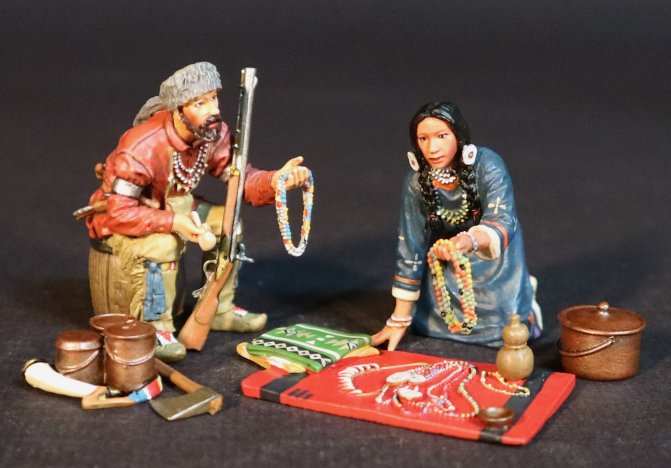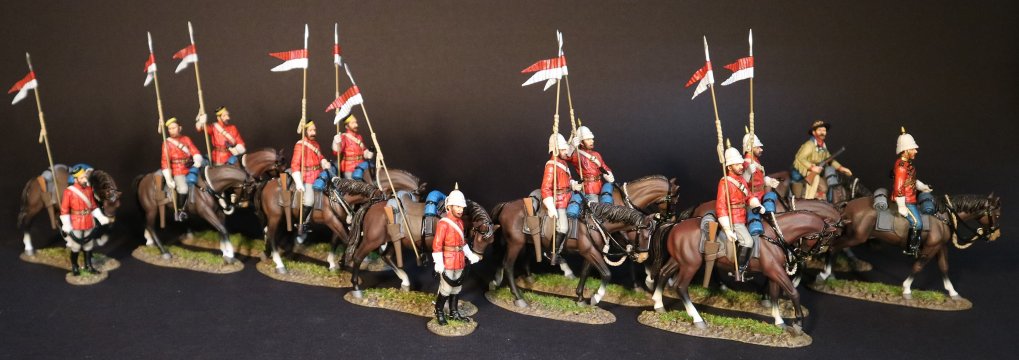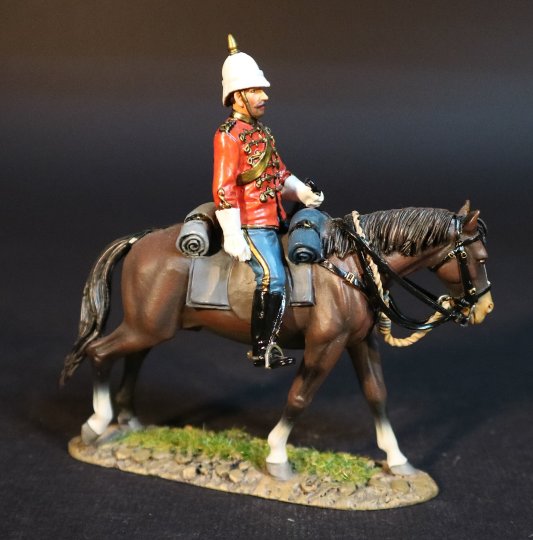- Joined
- Feb 2, 2011
- Messages
- 2,093
NEW RELEASES FOR MARCH 2024
THE FUR TRADE
MOUNTAIN MEN - THE RENDEZVOUS
A mountain man was an explorer who lived in the wilderness. They were instrumental in opening up the various Emigrant Trails (widened into wagon roads) allowing Americans in the east to settle the new territories of the far west by organized wagon trains traveling over roads explored and in many cases, physically improved by the mountain men and the big fur companies originally to serve the mule train based inland fur trade.
Mountain men were most common in the North American Rocky Mountains from about 1810 through to the 1880s (with a peak population in the early 1840s). Approximately 3,000 mountain men ranged the mountains between 1820 and 1840, the peak beaver-harvesting period. While there were many free trappers, most mountain men were employed by major fur companies. The life of a company man was almost militarized. The men had mess groups, hunted and trapped in brigades and always reported to the head of the trapping party.
This man was called a "boosway", a bastardization of the French term bourgeois. He was the leader of the brigade and the head trader.
The Rendezvous was an annual gathering, at various locations held by a fur trading company at which trappers and mountain men sold their furs and hides and replenished their supplies.
Held every summer, the trappers came together for the Rendezvous (pronounced “Rondy-Voo”) It was a celebration like Christmas, New Year’s Eve and the Fourth of July all rolled into one.

WSP-65
THE FUR TRADE,
THE MOUNTAIN MEN,
THE RENDEZVOUS,
TRADERS
(7 pcs)
The large fur companies put together teamster driven mule trains which packed in whiskey and supplies into a pre-announced location each spring/summer and set up a trading fair- the Rendezvous.
Not only was the Rendezvous a place where the trappers could sell and trade their furs for all sorts of commodities, such as clothing, saddles, bridles, tobacco, and whiskey, but it was a place to meet traders who might wish to engage their services for the coming year.
These Rendezvous were known to be lively, joyous places, where all were welcome, fur trappers, Indians, native trapper wives, and children, travellers and even tourists who would venture from as far as Europe to observe the festivities.
By the mid-1830s, the annual event would attract up to 500 men.
They were described as events “full of myrth, songs, dancing, shouting, trading, running, singing, racing, target-shooting, yarns, frolics, with all sorts of extravagances that white men or Indians could invent!”
These events include many of the activities that were necessary for survival, centering on shooting, guns and shotguns; throwing knives and tomahawks; primitive archery; as well as cooking, dancing, singing, the telling of tall tales and of past rendezvous.
THE NORTH WEST MOUNTED POLICE
THE MARCH WEST
The NWMP was established by the Canadian government during the ministry of Prime Minister Sir John Macdonald who defined its purpose as “the preservation of peace and the prevention of crime” in the vast NWT.
Macdonald’s principal fear was that the activities of American traders which led to the Cypress Hills Massacre would lead to the First nations peoples killing American traders, which would lead to the United States military being deployed into the NWT to protect the lives of American citizens under the grounds that Canada was unable to maintain law and order in the region.
His greatest fear was that if the Americans occupied the NWT that they would not leave and the region would be annexed to the United States.

The NWMP was established in 1873, and were deployed to the area of the present Alberta border.
Their ill-planned and arduous journey of nearly 900 miles became known as the March West, and is portrayed as an epic journey of endurance.
Over the next few years, the NWMP established a wide network of forts, posts and patrols and extended Canadian law across the region. The living conditions of the NWMP on the prairies were spartan and often uncomfortable, and only slowly improved over the course of the century.

WSP-70
THE FUR TRADE,
THE NORTH WEST MOUNTED POLICE,
COLONEL GEORGE ARTHUR FRENCH.
(2 pcs)
(RCMP USED UNDER LICENCE)
Walsh’s original role was to shut down this trade, but in June 1876 his position grew in importance when several thousand Sioux crossed the border into Canada, taking refuge there after the Battle of Little Big Horn.
Walsh developed a strong friendship with the famous Sioux leader Sitting Bull, and successfully kept peace in the region. Walsh became famous in the American press as “Sitting Bull’s Boss”.
In reality Walsh’s orders were to convince Sitting Bull and the Sioux to return to the United States, but the Canadian government decided that Walsh’s friendship with Sitting Bull was an obstacle to the Sioux’s return across the border.
In 1880 Walsh was transferred to Fort Qu’Appelle, Saskatchewan, and soon after he reluctantly resigned his commission.
In August 1897 during the height of the Klondike Gold Rush, Walsh was appointed Commissioner of the newly created Yukon Territory. He resigned in 1898, returning to Ontario where he died in 1905.
Mount Walsh a mountain peak in the Saint Elias Mountains in the Yukon is named after him.
For those interested in learning more about James Morrow Walsh and Sitting Bull, Ian Anderson’s book “Sitting Bull’s Boss, Above the Medicine Line with James Morrow Walsh” is recommended.
ISBN 1-895811-63-5
** PLEASE CONTACT YOUR LOCAL DEALER FOR FURTHER INFORMATION **
THE FUR TRADE
MOUNTAIN MEN - THE RENDEZVOUS
A mountain man was an explorer who lived in the wilderness. They were instrumental in opening up the various Emigrant Trails (widened into wagon roads) allowing Americans in the east to settle the new territories of the far west by organized wagon trains traveling over roads explored and in many cases, physically improved by the mountain men and the big fur companies originally to serve the mule train based inland fur trade.
Mountain men were most common in the North American Rocky Mountains from about 1810 through to the 1880s (with a peak population in the early 1840s). Approximately 3,000 mountain men ranged the mountains between 1820 and 1840, the peak beaver-harvesting period. While there were many free trappers, most mountain men were employed by major fur companies. The life of a company man was almost militarized. The men had mess groups, hunted and trapped in brigades and always reported to the head of the trapping party.
This man was called a "boosway", a bastardization of the French term bourgeois. He was the leader of the brigade and the head trader.
The Rendezvous was an annual gathering, at various locations held by a fur trading company at which trappers and mountain men sold their furs and hides and replenished their supplies.
Held every summer, the trappers came together for the Rendezvous (pronounced “Rondy-Voo”) It was a celebration like Christmas, New Year’s Eve and the Fourth of July all rolled into one.

WSP-65
THE FUR TRADE,
THE MOUNTAIN MEN,
THE RENDEZVOUS,
TRADERS
(7 pcs)
The large fur companies put together teamster driven mule trains which packed in whiskey and supplies into a pre-announced location each spring/summer and set up a trading fair- the Rendezvous.
Not only was the Rendezvous a place where the trappers could sell and trade their furs for all sorts of commodities, such as clothing, saddles, bridles, tobacco, and whiskey, but it was a place to meet traders who might wish to engage their services for the coming year.
These Rendezvous were known to be lively, joyous places, where all were welcome, fur trappers, Indians, native trapper wives, and children, travellers and even tourists who would venture from as far as Europe to observe the festivities.
By the mid-1830s, the annual event would attract up to 500 men.
They were described as events “full of myrth, songs, dancing, shouting, trading, running, singing, racing, target-shooting, yarns, frolics, with all sorts of extravagances that white men or Indians could invent!”
These events include many of the activities that were necessary for survival, centering on shooting, guns and shotguns; throwing knives and tomahawks; primitive archery; as well as cooking, dancing, singing, the telling of tall tales and of past rendezvous.
THE NORTH WEST MOUNTED POLICE
THE MARCH WEST
The NWMP was established by the Canadian government during the ministry of Prime Minister Sir John Macdonald who defined its purpose as “the preservation of peace and the prevention of crime” in the vast NWT.
Macdonald’s principal fear was that the activities of American traders which led to the Cypress Hills Massacre would lead to the First nations peoples killing American traders, which would lead to the United States military being deployed into the NWT to protect the lives of American citizens under the grounds that Canada was unable to maintain law and order in the region.
His greatest fear was that if the Americans occupied the NWT that they would not leave and the region would be annexed to the United States.

The NWMP was established in 1873, and were deployed to the area of the present Alberta border.
Their ill-planned and arduous journey of nearly 900 miles became known as the March West, and is portrayed as an epic journey of endurance.
Over the next few years, the NWMP established a wide network of forts, posts and patrols and extended Canadian law across the region. The living conditions of the NWMP on the prairies were spartan and often uncomfortable, and only slowly improved over the course of the century.

WSP-70
THE FUR TRADE,
THE NORTH WEST MOUNTED POLICE,
COLONEL GEORGE ARTHUR FRENCH.
(2 pcs)
(RCMP USED UNDER LICENCE)
Walsh’s original role was to shut down this trade, but in June 1876 his position grew in importance when several thousand Sioux crossed the border into Canada, taking refuge there after the Battle of Little Big Horn.
Walsh developed a strong friendship with the famous Sioux leader Sitting Bull, and successfully kept peace in the region. Walsh became famous in the American press as “Sitting Bull’s Boss”.
In reality Walsh’s orders were to convince Sitting Bull and the Sioux to return to the United States, but the Canadian government decided that Walsh’s friendship with Sitting Bull was an obstacle to the Sioux’s return across the border.
In 1880 Walsh was transferred to Fort Qu’Appelle, Saskatchewan, and soon after he reluctantly resigned his commission.
In August 1897 during the height of the Klondike Gold Rush, Walsh was appointed Commissioner of the newly created Yukon Territory. He resigned in 1898, returning to Ontario where he died in 1905.
Mount Walsh a mountain peak in the Saint Elias Mountains in the Yukon is named after him.
For those interested in learning more about James Morrow Walsh and Sitting Bull, Ian Anderson’s book “Sitting Bull’s Boss, Above the Medicine Line with James Morrow Walsh” is recommended.
ISBN 1-895811-63-5
** PLEASE CONTACT YOUR LOCAL DEALER FOR FURTHER INFORMATION **


